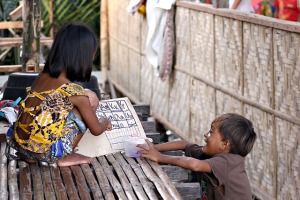
To see the Badjaos transformed into educated individuals was a “huge improvement” in their community, said Sister Evelyn Flanagan of the Presentation Sisters of the Blessed Virgin Mary. It’s the Presentation Sisters who are sending the Badjao children to school since 1996. In 2008, after seeing a growth in the student population, the congregation built the two-story Nano Nagle Child Care and Learning Center, Inc., which presently prepares 90 young Badjaos for grade school, and teach their parents how to read and write.
“We have 11 graduates in college, 90 children in pre-school, 127 in elementary, 232 in high school.We see the interest of the parents in having their children go to school, to have the freedom, away from discrimination. That’s a huge improvement,” said Sr. Evelyn.

Venerva Amil, who was born and raised by a Badjao family, believes that people ridicule them because they are different. But she said education can set that issue right. Once being called many names in high school because of her being different, Amil, a scholar of the Presentation Sisters from grade school to college, now 25, is a graduate of Bachelor in Elementary Education. She is one of the teachers at the learning center. She said she wants to be a part of that long-term project in educating her fellow Badjaos, as she believes that education is key to earning public respect. It will also give them better opportunities, and subsequently keep them off the streets in the future, she added.
“Some Badjaos beg not because they don’t have anything to eat. They beg because they have nothing else to do. This is why, for me, they have to be educated, to change their mindset,” she said.
Teaching the Badjaos, whose families’ main concern is how to bring food on their table, was not a walk in the park for the Cebuano teachers, said Annie Alterado, a teacher at the learning center since 2003. She recalled that in her first years, about 90 percent of their pupils would leave school two months after the opening to go with their families in their next fishing expedition. Back then the fathers would bring their entire families as they set out for these fishing trips, she said. But times have changed, if before the whole community was composed of 97 percent illiterate individuals, that number has droppedexponentially with children getting the right education, and the parents understand the need to educate the young ones, she added. About 70 percent of the adult Badjaos are also registered voters.
But the problem does not end there, said Alterado. She said most of their pupils are still afraid to go outside of their

comfort zone, which is their community. Of the 90 pupils they have, only about 35 are prepared to advance to grade one in June, she said. The learning center is a preparatory school for Badjao children, where they are taught the basics in elementary education and socializing. Only those considered ready are sent to the Mambaling Elementary School. This Presentation Sisters thought of having this procedure after their epic fail at the start of their operation. Sister Evelyn said that during their first year at the community, they made a mistake by sending all the school-age children to MES right away. After two weeks, all of the children stopped schooling altogether because of culture shock. The congregationthen went on by housing the children within their community, initially inside the rented houses of Badjao families, to teach them the basics.
Amil was a living witness to this episode. She said only a few of them in her batch made it to college, some even
dropped out. She blamed society for it, for their constant bullying, and partly her tribe mates for their lack of courage and self-esteem. This is the reason why she is helping the Presentation Sisters by teaching the children including those of her childhood friends’, she said. As of this school year, the program, which provides all the students’ needs from tuition to books, has seen 11 Badjaos, including Amil, who finished their college degrees.
Sr. Evelyn also hopes the same: the Badjaos can stand on their own, years from now. She said that is their main purpose in giving them education. “Before the Badjaos were too illiterate, but now they’re learning. And that’s really good…to keep them from being discriminated,” said Sr. Evelyn.
Source: http://www.philstar.com/cebu-news/2013/02/18/910267/badjaos-their-real-story
Discrimination on the Illiteracy of Badjaos
Putting up an education center will help a lot in eradicating the discrimination against the illiteracy of Badjaos. If they learn how to read and write they won’t have to beg for money to feed their families. This is a great step towards the growth of the Badjao tribe.

